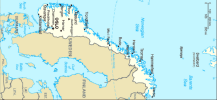|
| |
|
You have arrived at our
Archive Site. We have recently remodeled and if you click the Home
button you will be transported to our new word press site. If you
are on a product page, all the BUY NOW buttons have been updated to go
directly to the new word press product page. Please update your bookmarks
to https://www.celticattic.com
Scandinavia
|
|
Scandinavia - History Fact & Fiction



|
|
Click on the links below to access our History, Facts
& Fiction, Links and Products pages about each of the Scandinavian
Nations. |
|
|
The Viking age (8th
to
11th centuries) was one of national unification and expansion.
The
Norwegian royal line died out in
1387,
and the country entered a long period as the weaker part of a union
with
Denmark. With the forced introduction of Protestantism in
1537,
Norway lost the steady stream of pilgrims to the relics of
Saint Olav at the
Nidaros shrine. With them, ironically, went much of the contact
with the cultural and economical life of the rest of Europe. In
light of national romanticism during the
19th century, this period was by some called the "400-year
night".
After
Denmark-Norway sided with
Napoleon in the
Napoleonic Wars, Norway was ceded to the king of
Sweden
in 1814.
However, Norway declared her independence, adopted her own constitution
and elected the Danish prince Christian Fredrik as king on 17
May
1814. Norway was forced into a
personal union with
Sweden,
but kept its liberal constitution and independent institutions, except
for the foreign service. Growing Norwegian dissatisfaction with the
union during the late
19th century spawned its dissolution
7 June
1905.
The Norwegian government offered the throne of Norway to Danish Prince
Carl. After a
plebiscite confirming the monarchy, the Parliament unanimously
elected him king. He took the name of
Haakon VII, after the medieval kings of independent Norway.
Norway was a neutral country during
World War I. Norway also attempted to claim neutrality during
World War II, but was invaded by German forces on the 9th of
April 1940
(Operation
Weserübung). The Allies also had plans to operate from Norway,
in order to take advantage of her strategically important Atlantic
coast. Armed resistance in Norway went on for two months, but the King
and government continued the fight from exile in Britain. On the day
of the invasion, the collaborative leader of the small
National-Socialist party
Nasjonal Samling –
Vidkun Quisling – tried to seize power, but was forced by the
German occupiers to step aside. Real power was wielded by the leader
of the German occupation authority, Reichskommissar
Josef Terboven. Quisling, as minister president, later
formed a government under German control.
In 1944,
the Germans evacuated the provinces of
Finnmark and northern
Troms,
using a
scorched earth tactic. The
Red
Army moved in shortly after, and peacefully returned the area to
Norwegian control after the war, despite
President Roosevelt having offered them parts of northern
Norway. The Germans in Norway surrendered on
8 May
1945.
The occupation during
World War II made Norwegians generally more skeptical of the
concept of neutrality. They turned instead to
collective security. Norway was one of the signatories of the
North Atlantic Treaty in
1949
and was a founding member of the
United Nations, providing its first secretary general –
Trygve Lie. Norway has twice voted against joining the
European Union (in
1972
and 1994),
but is associated with the EU via the
European Economic Area. Since then at various times a large
majority has been in favour of joining the Union and consequently the
EU debate rages on to this day.
http://en.wikipedia.org/wiki/Norway
|